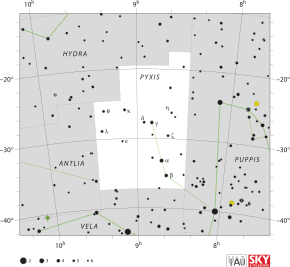| Constellation | |
 | |
| Abbreviation | Pyx |
|---|---|
| Genitive | Pyxidis |
| Pronunciation | /ˈpɪksɪs/, genitive /ˈpɪksɪdɪs/ |
| Symbolism | The compass box |
| Right ascension | 9h |
| Declination | −30° |
| Quadrant | SQ2 |
| Area | 221 sq. deg. (65th) |
| Main stars | 3 |
| Bayer/Flamsteed stars | 10 |
| Stars with planets | 3 |
| Stars brighter than 3.00m | 0 |
| Stars within 10.00 pc (32.62 ly) | 1 |
| Brightest star | α Pyx (3.68m) |
| Messier objects | 0 |
| Bordering constellations | Hydra Puppis Vela Antlia |
| Visible at latitudes between +50° and −90°. Best visible at 21:00 (9 p.m.) during the month of March. | |
Pyxis[a] is a small and faint constellation in the southern sky. Abbreviated from Pyxis Nautica, its name is Latin for a mariner's compass (contrasting with Circinus, which represents a draftsman's compasses). Pyxis was introduced by Nicolas-Louis de Lacaille in the 18th century, and is counted among the 88 modern constellations.
The plane of the Milky Way passes through Pyxis. A faint constellation, its three brightest stars—Alpha, Beta and Gamma Pyxidis—are in a rough line. At magnitude 3.68, Alpha is the constellation's brightest star. It is a blue-white star approximately 880 light-years (270 parsecs) distant and around 22,000 times as luminous as the Sun.
Pyxis is located close to the stars that formed the old constellation Argo Navis, the ship of Jason and the Argonauts. Parts of Argo Navis were the Carina (the keel or hull), the Puppis (the stern), and the Vela (the sails). These eventually became their own constellations. In the 19th century, John Herschel suggested renaming Pyxis to Malus (meaning the mast) but the suggestion was not followed.
T Pyxidis, located about 4 degrees northeast of Alpha Pyxidis, is a recurrent nova that has flared up to magnitude 7 every few decades. Also, three star systems in Pyxis have confirmed exoplanets. The Pyxis globular cluster is situated about 130,000 light-years away in the galactic halo. This region was not thought to contain globular clusters. The possibility has been raised that this object might have escaped from the Large Magellanic Cloud.[3]
- ^ pyxis. Charlton T. Lewis and Charles Short. A Latin Dictionary on Perseus Project.
- ^ πυξίς. Liddell, Henry George; Scott, Robert; A Greek–English Lexicon at the Perseus Project.
- ^ Cite error: The named reference
Irwin 1995was invoked but never defined (see the help page).
Cite error: There are <ref group=lower-alpha> tags or {{efn}} templates on this page, but the references will not show without a {{reflist|group=lower-alpha}} template or {{notelist}} template (see the help page).